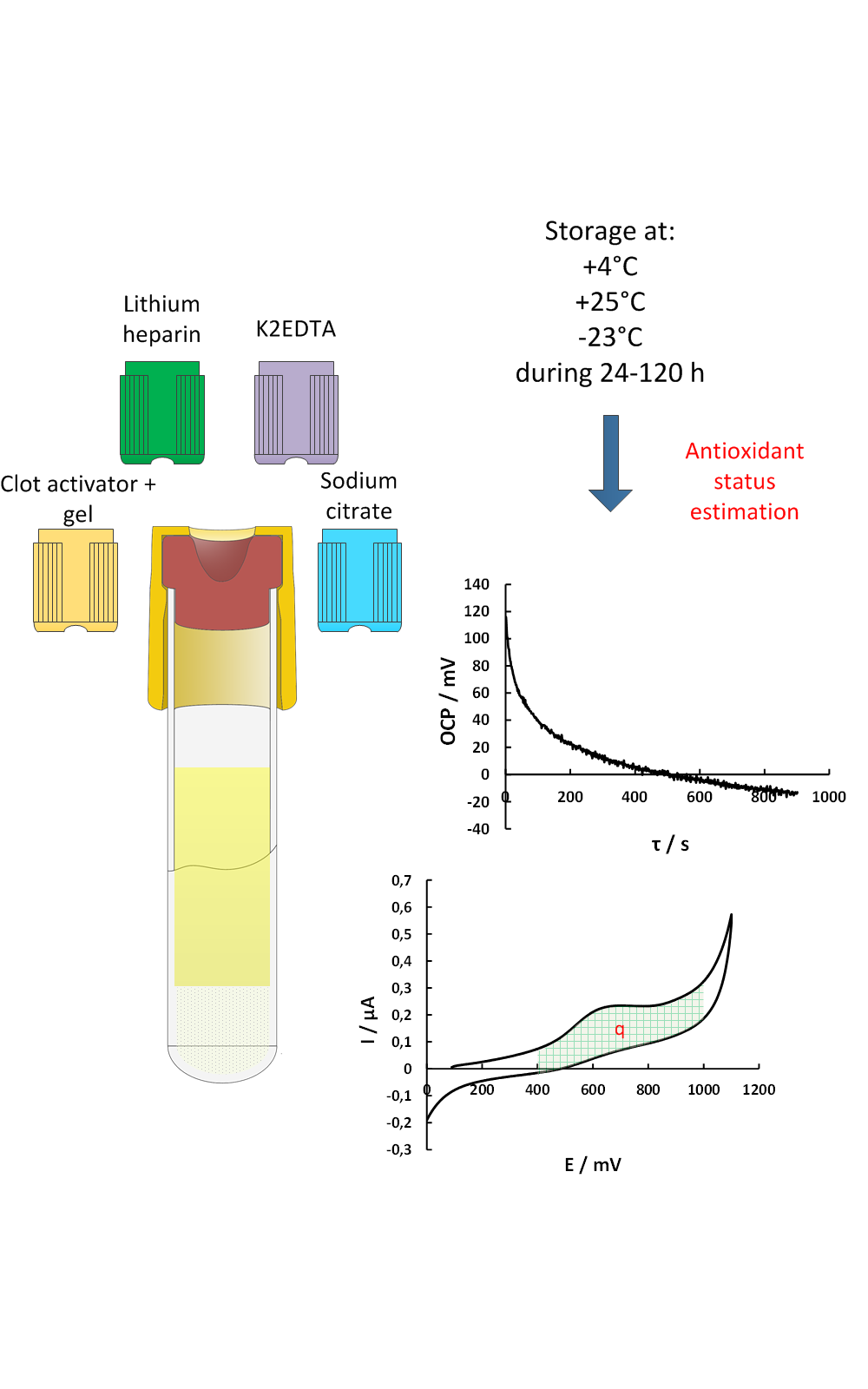Electrochemical analysis of antioxidant status of biological media in different sampling and storage conditions Scientific paper
Main Article Content
Abstract
The use of an electrochemical approach for assessment of the oxidative stress severity is a promising direction for point-of-care testing development, which is especially important for critically ill patients. The aim of this study was to determine the influence of different types of blood collection tubes (with clot activator and separating gel, lithium heparin, sodium citrate and K2EDTA) and storage conditions (at 25, 4 and –23 °C up to 5 days) on the electrochemical analysis of the antioxidant status of blood plasma, assessed by measuring the open circuit potential of platinum electrode (OCP) and antioxidant capacity via cyclic voltammetry method (q). It was obtained that blood collection tubes with lithium heparin and clot activator are the most suitable for the electrochemical analysis of antioxidant status of blood plasma, since they do not affect the results of measurements. Furthermore, data obtained during storage blood plasma samples in different temperature conditions indicate that it is preferable to perform electrochemical analysis in fresh samples.
Downloads
Metrics
Article Details

This work is licensed under a Creative Commons Attribution 4.0 International License.

Authors retain copyright and grant the journal right of first publication with the work simultaneously licensed under a Creative Commons Attribution license 4.0 that allows others to share the work with an acknowledgement of the work's authorship and initial publication in this journal.
References
A. F. Rogobete, D. Sandesc, M. Papurica, E. R. Stoicescu, S. E. Popovici, L. M. Bratu, C. Vernic, A. M. Sas, A. T. Stan, O. H. Bedreag, Burns Trauma 5 (2017) 8 (https://doi.org/10.1186/s41038-017-0073-0)
M. Simic, J. Kotur-Stevuljevic, P. Jovanovic, M. Petkovic, M. Jovanovic, G. Tasic, V. Savic, J. Serb. Chem. Soc. 88 (2023) 589 (https://doi.org/10.2298/JSC221221017S)
I. V. Goroncharovskaya, A. K. Evseev, A. K. Shabanov, O. Denisenko, Electroanalysis 33 (2021) 550 (https://doi.org/10.1002/elan.202060356)
A. K. Shabanov, A. K. Evseev, I. V. Goroncharovskaya, S. A. Badygov, R. A. Cherpakov, V. V. Kulabukhov, E. V. Klychnikova, N. V. Borovkova, O. A. Grebenchikov, S. S. Petrikov, Polytrauma 4 (2022) 56 (https://doi.org/10.24412/1819-1495-2022-4-56-65)
D. Polson, N. Villalba, K. Freeman, Redox Rep. 23 (2018) 125 (https://doi.org/10.1080/13510002.2018.1456000)
H.-W. Wang, C. Bringans, A. J. R. Hickey, J. A. Windsor, P. A. Kilmartin, A. R. J. Phillips, Signals 2 (2021) 138 (https://doi.org/10.3390/signals2010012)
M. Selaković, M. M. Aleksić, J. Kotur-Stevuljević, J. Rupar, B. Ivković, Molecules 28 (2023) 2113 (https://doi.org/10.3390/molecules28052113)
G. Lippi, A. von Meyer, J. Cadamuro, A.-M. Simundic, Diagnosis 6 (2019) 25 (https://doi.org/10.1515/dx-2018-0018)
R. A. R. Bowen, A. T. Remaley, Biochem. Med. 24 (2014) 31 (https://doi.org/10.11613/BM.2014.006)
C. Oddoze, E. Lombard, H. Portugal, Clin. Biochem. 45 (2012) 464 (https://doi.org/10.1016/j.clinbiochem.2012.01.012)
N. Ayala-Lopez, S. E. Conklin, B.J. Tenney, M. Ness, M. A. Marzinke, Clin. Chim. Acta 520 (2021) 118 (https://doi.org/10.1016/j.cca.2021.05.019)
A. Bastin, S. Fooladi, A. H. Doustimotlagh, S. Vakili, A. H. Aminizadeh, A. Faramarz, H. Shiri, M. H. Nematollahi, PLoS One 17 (2022) e0266567 (https://doi.org/10.1371/journal.pone.0266567)
C. Ialongo, Clin. Biochem. 50 (2017) 356 (https://doi.org/10.1016/j.clinbiochem.2016.11.037)
J. M. Pullar, S. Bayer, A. C. Carr, Antioxidants 7 (2018) 29 (https://doi.org/10.3390/antiox7020029)
D. Duplancic, L. Kukoc-Modun, D. Modun, N. Radic, Molecules 16 (2011) 7058 (https://doi.org/10.3390/molecules16087058)
E. H. J. M. Jansen, P. K. Beekhof, J. W. J. M. Cremers, D. Viezeliene, V. Muzakova, J. Skalicky, Biomarkers 2013 (2013) Article ID 316528 (https://dx.doi.org/10.1155/2013/316528)
L. Pawlik-Sobecka, K. Sołkiewicz, I. Kokot, A. Kiraga, S. Płaczkowska, A. M. Schlichtinger, E. M. Kratz, Diagnostics 10 (2020) 51 (https://doi.org/10.3390/diagnostics10010051)
I. V. Goroncharovskaya, V. B. Khvatov, A. K. Evseev, A. K. Shabanov, M. M. Goldin, S. S. Petrikov, Gen. Reanimatol. 15 (2019) 47 (https://doi.org/10.15360/1813-9779-2019-1-47-53)
B. L. Boyanton, K. E. Blick, Clin. Chem. 48 (2002) 2242 (https://doi.org/10.1093/clinchem/48.12.2242)
M. Donten, J. Osteryoung, J. Appl. Electrochem. 21 (1991) 496 (https://doi.org/10.1007/BF01018601)
O. I. González-Peña, T. W. Chapman, Y. M. Vong, R. Antaño-López, Electrochim. Acta 53 (2008) 5549 (https://doi.org/10.1016/j.electacta.2008.02.104)
B. Zhao, W. Zhu, T. Mu, Z. Hu, T. Duan, Int. J. Environ. Res. Public Health 14 (2017) 819 (https://doi.org/10.3390/ijerph14070819)
J. W. Johnson, H. W. Jiang, S. B. Hanna, W. J. James, J. Electrochem. Soc. 119 (1972) 574 (https://doi.org/10.1149/1.2404264).





